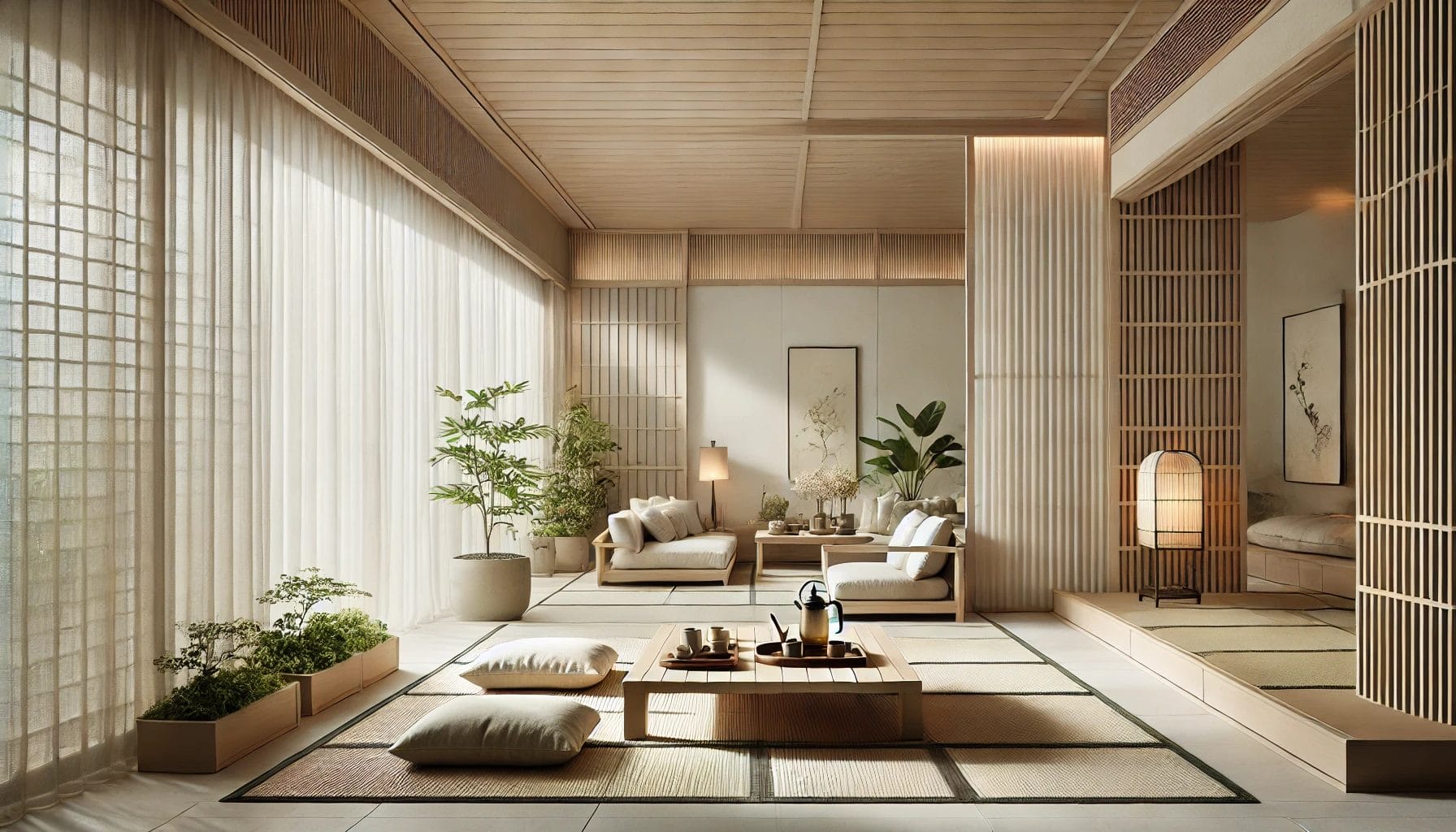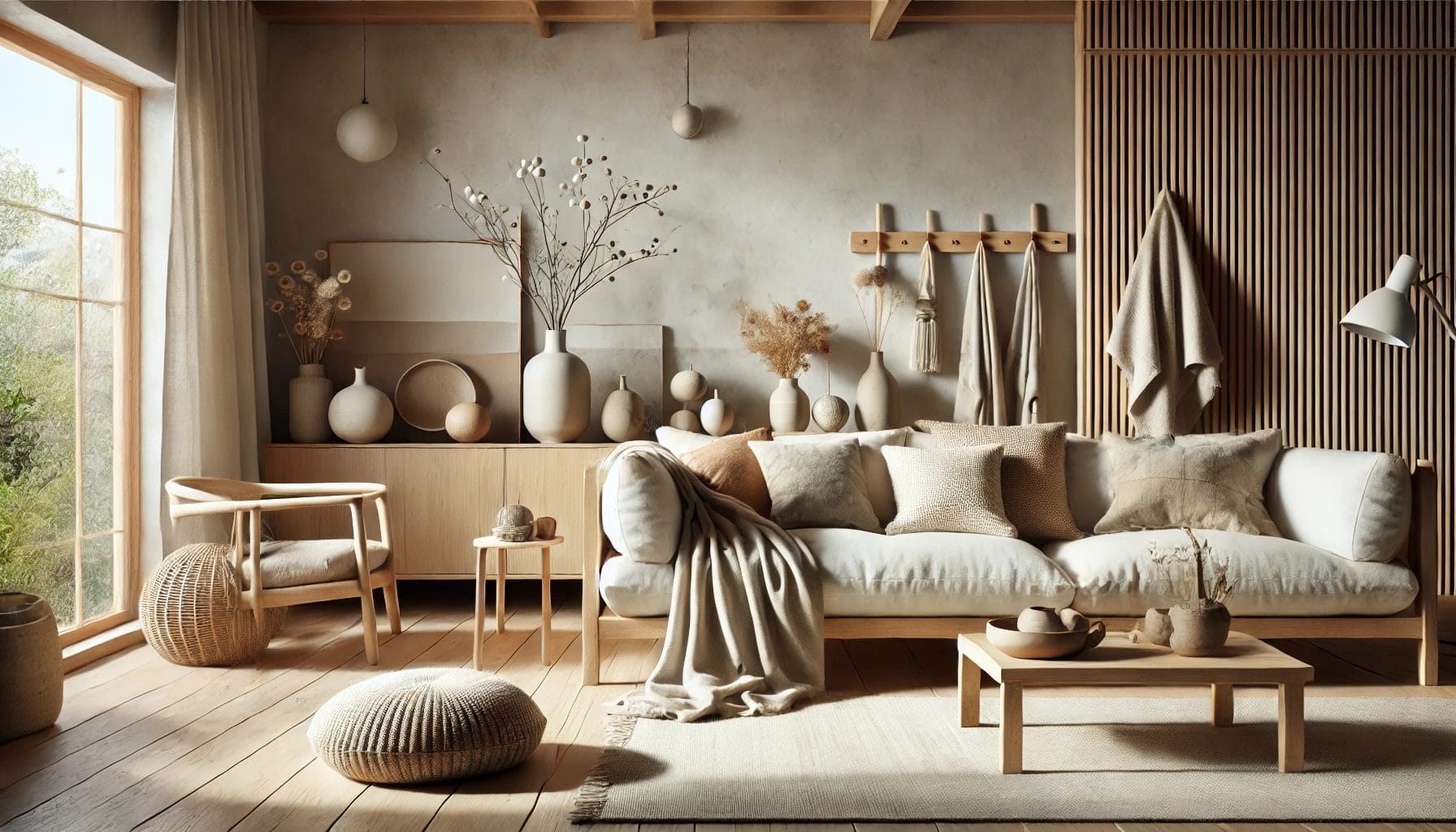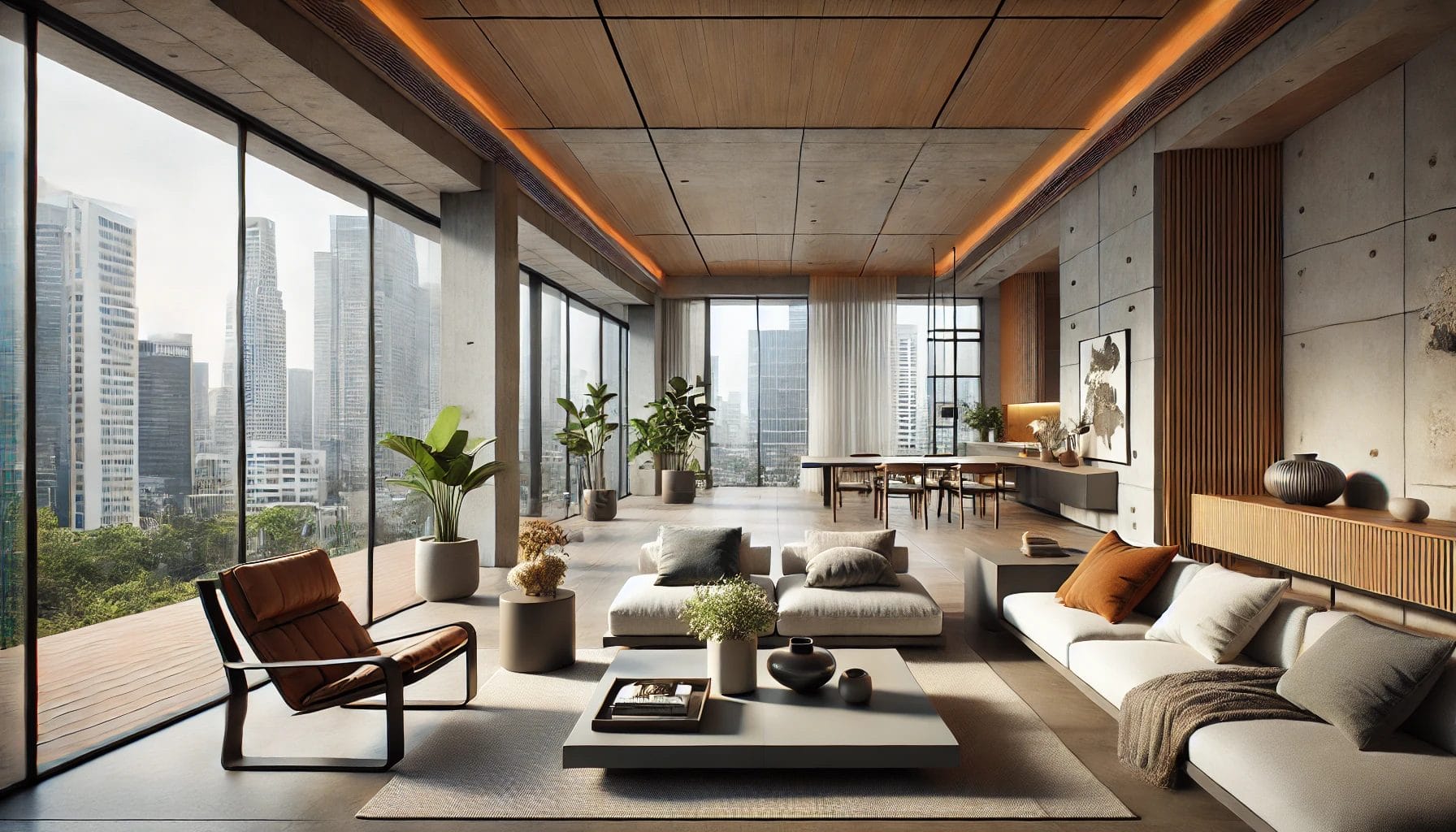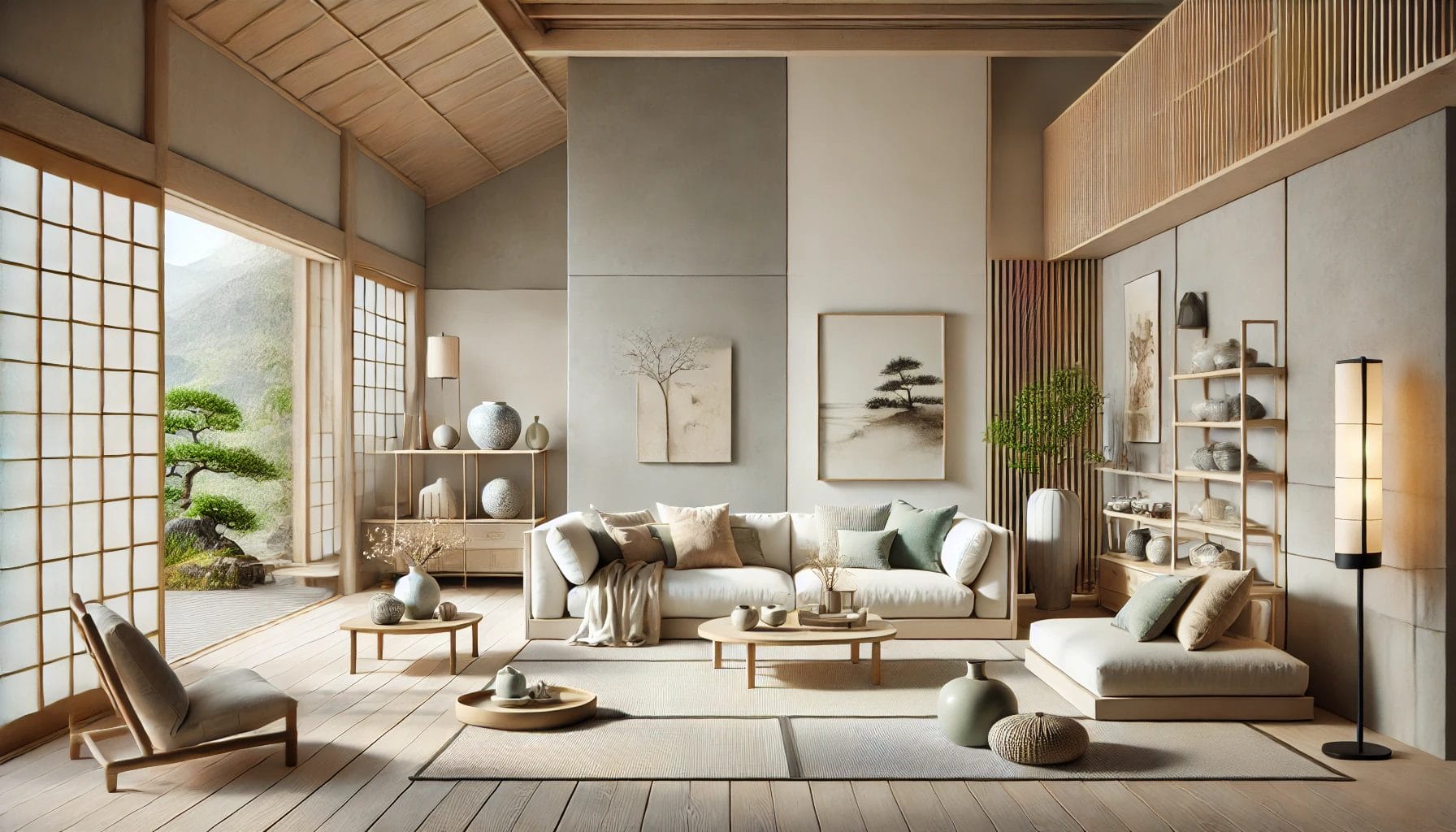Japanese interior design brings a special way to make a calm and balanced living space. It is not only about how things look. This design style focuses on simplicity, natural elements, and being close to nature. It changes your home into a peaceful place. This design approach is more than just looks.
It encourages a thoughtful and purposeful lifestyle. It values simplicity, practical ways of living, and the beauty found in the natural world.

Key Highlights
- Japanese interior design focuses on keeping things simple. It uses natural elements and connects deeply with nature.
- Important parts include minimalism, natural materials like wood and paper, and a focus on natural light.
- It promotes harmony and balance, filling spaces with peace and calm.
- You can add Japanese interior design to modern homes by choosing the right furniture, colors, and how you use space.
- This style encourages a thoughtful way of living, where each piece has a purpose and adds to a calm feeling.
Understanding Japanese Interior Design

Rooted in Japan’s culture and philosophy, this design style focuses on calmness, balance, and a strong link to nature. It is more than just looks; it is a way of thinking that promotes a careful and thoughtful way to design and live in a space. It values the beauty of simplicity and the role of natural elements.
Japanese interior design, at its heart, aims for a peaceful relationship between nature and human-made things. This creates a calm and supportive feel in the home.
The Philosophy Behind Japanese Aesthetics
Central to Japanese culture is a deep love for nature and the quick changes of life. This shows in their design philosophy. They believe in ideas like ‘wabi-sabi,’ which means seeing beauty in things that are not perfect. They also value ‘ma,’ which highlights the importance of empty space.
Their design philosophy uses natural materials, forms that look like nature, and soft colors. This creates a space that is calming and nice to look at. The design connects the inside of a home to the outside, blending the boundaries and letting nature flow into the home.
Key Elements of Japanese Interior Design in Singapore
Japanese style uses natural materials like wood, bamboo, paper, and stone. These materials look good and age well, showing the marks of time and use. The furniture pieces are simple and have clean lines. They focus on being useful.
Also, this style aims to make spaces feel open, even in small homes. To do this, it uses open floor plans and has minimal furniture. Furniture is placed carefully to allow for easy movement.

Preparing to Incorporate Japanese Design into Your Home
Taking ideas from Japanese design can feel like starting a journey toward a more mindful life. Before jumping into a big renovation, understand what elements you truly like. A good first step is to simplify your living space. This means decluttering and reorganizing your things to bring calm and clarity.
Think about how natural light moves through your home during the day. Japanese design embraces natural light. Adding it to your space can greatly change the mood and feel of your home.

Essential Resources and Materials for a Japanese-Style Revamp
When you want to add Japanese design to your home, start by using natural materials. Good choices for furniture, flooring, or accent walls are woods like cedar, cypress, and bamboo. You can also use ‘shou sugi ban,’ a unique Japanese method that burns wood. This can give your space an interesting texture and look.
Paper lanterns are a big part of Japanese style, too. They can create soft light and make your home feel warm and inviting. For an elegant look, search for authentic ‘washi’ paper lanterns.
Finding Inspiration: Japanese Interior Design Examples in Singapore
Singapore has a lively design scene. Many skilled interior designers focus on modern Japanese interiors. Look for local design firms and check their portfolios to find some design ideas. Notice how they blend traditional elements with modern spaces.
You can get more inspiration by visiting showrooms that showcase Japanese-inspired furniture and homeware. There are also many online resources available. Design blogs and Pinterest boards are great places to find lots of ideas for Japanese interior design.
A Beginner’s Guide to Japanese Interior Design

Transforming your home with Japanese design principles is easy, even if you are new to it. You can start slowly by adding things that you really like. Small changes, like getting one piece of Japanese-inspired furniture or a special set of ceramics, can have a big impact.
As you feel more confident with the design principles, you can add more elements. Over time, your space can show your own style and the calmness of Japanese aesthetics.
What You Need to Get Started
Before you start with Japanese interior design, it’s important to know the basic design elements. Decluttering your space is key. This helps create an open and calm feeling. People use natural materials like wood, bamboo, and stone. These materials age nicely and help bring the outdoors inside.
Think about how you use your space. Japanese design focuses on using space well. Furniture is chosen for its clean lines and simple style. Natural light is very important in this design. You should make the most of your windows. Use sheer curtains or shoji screens to let in light softly.
Step 1: Decluttering Your Space with the KonMari Method
The first step to making a Japanese-inspired space is to clean up. The KonMari Method from Marie Kondo gives a practical way to do this. Instead of looking at what to throw away, she tells you to keep things that “spark joy.” This fits well with Japanese design philosophy.
Start by checking your things, one category at a time. Hold each item and see if it brings you joy. If it doesn’t, thank it and let it go. By getting rid of things you don’t need, you will make your home feel calm and organized. Just think about coming back to a clean, minimalist space after a long day – it will be so relaxing!
Step 2: Integrating Natural Elements for Harmony
Japanese design focuses on bringing natural elements inside your home. You can do this by adding houseplants, using natural materials for your furniture and floors, and letting in natural light. Good choices include wood, bamboo, stone, and paper, as they help connect indoors with the outdoors.
Think about adding large windows or skylights. This will let in natural light and make your living space feel brighter. It also connects you more with the natural world outside. Embrace the beauty of imperfection. Choosing raw, unfinished materials highlights the unique character of nature and how it changes over time.
Step 3: Selecting Minimalist Furniture with a Focus on Functionality
When you choose furniture for your Japanese-inspired home, pick simple and useful designs. Japanese furniture is usually low to the ground. This makes the space feel bigger and gives a stable seating experience. Look for furniture pieces made from natural materials like wood, bamboo, or rattan.
Stay away from heavy or fancy furniture. Focus on clean lines and simple styles. Multi-functional furniture also works well, especially in small areas. Think about a low platform bed with storage or a coffee table that can be a dining table too.
Step 4: Embracing the Concept of ‘Ma’ for Spatial Awareness
One important idea in Japanese home design is called ‘ma.’ This means using negative space or empty areas in a room. It’s about valuing emptiness and giving enough space around furniture and objects. You should not fill your space too much. Instead, choose your furniture carefully. Keep some areas open to help create calm and quiet feelings.
Rather than using solid walls, think about putting up room dividers or shoji screens. These can help separate areas while still letting light come in. You can easily move or change the position of these screens. They not only give you flexibility but also add a nice traditional look. By using ‘ma,’ you can make your space feel balanced and peaceful, helping you relax.
Step 5: Incorporating Traditional Japanese Decorative Elements
While it’s important to keep things simple, adding some decorative elements can improve the Japanese look of your home. Think about using traditional Japanese items like a ‘tokonoma’, which is a small space for showing art or flowers, or a ‘tansu’, a classic Japanese chest of drawers.
You can also use Japanese fabrics like ‘furoshiki’ wrapping clothes or ‘noren’ curtains for doorways. These fabrics usually have simple designs inspired by nature. They bring a bit of traditional Japanese style to your home. Just remember not to create clutter. Pick a few decorative elements that you love and that fit well with the overall design.
Interesting Ideas For Japanese Interior Design Singapore
Japanese interior design fits well with Singapore’s busy city life. It creates a calm place away from the noise. This style focuses on natural elements, simple looks, and smart use of space. It works perfectly for HDB apartments and condos.
You can add this peaceful style to your whole home or just one room. There are many ideas that mix Japanese design principles with Singapore’s modern way of living.

Modern Japanese Interior Design
Modern Japanese design keeps the main ideas of simplicity and usefulness. It adds some new elements too. This style features clean lines and a neutral color palette, mixed with bold colors. It uses modern materials with traditional ones.
Imagine sleek furniture that is simple and elegant. Think of concrete paired with warm wood. Large windows bring in city views and lots of natural light. Nature plays a big role here, with plants placed nicely and light that makes the space feel peaceful. Modern Japanese aesthetics fit perfectly in a contemporary Singaporean home.
Japanese Scandinavian Interior Design — Japandi Style

Japandi style combines the simple beauty of Japanese design with the warm charm of Scandinavian styles. This style finds a nice balance between clean lines and rustic textures. It also mixes practicality with a feeling of ‘hygge,’ which is about comfort and happiness.
Think of light wood furniture that has smooth shapes. Picture natural fabrics like linen and wool, along with soft colors that have hints of earthy shades. Japandi style loves the beauty of imperfection. It focuses on natural materials and handmade items.
Japanese Minimalist Interior Design
Japanese minimalist interior design follows the idea of ‘less is more’. It aims to create a calm and tidy space where each item serves a clear purpose. There is very little furniture, and it features clean lines and simple designs.
A neutral color palette, often using white, beige, or grey, brings a sense of peace and space. The emphasis is on being functional, letting in natural light, and creating openness. This minimalist approach isn’t about having nothing. It’s about choosing things thoughtfully to promote peace and clarity in your home.

Zen-Inspired Japanese Interior Design
Zen-inspired Japanese interior design focuses on making a peaceful space. This type of design aims to encourage meditation and being present in the moment. It values simplicity, using very little furniture, soft colors, and natural materials.
Soft lighting is important, often provided by paper lanterns or lamps placed in thoughtful spots. This creates a relaxing and thoughtful mood. Adding natural elements, like plants, water features, or stone gardens, helps link the space to the calming effects of nature.
Accentuating Your Home with Japanese Design Principles

You can turn your home into a calm space by using Japanese design ideas, even if you don’t want to do big changes. Start by cleaning up and sorting your things. Let go of items you don’t need. This will help make your home feel bigger and more organized.
Add natural elements like plants, bamboo blinds, or a little water feature to bring peace. Use soft lighting and work on creating a smooth flow in your home. This will give you a whole new look.
The Role of Natural Light and Airflow
Natural light is very important in Japanese design. It brightens spaces and makes people feel good. You can add large windows or skylights to let in more natural light. If you want privacy, use translucent shades or shoji screens. These can let in light while keeping your space open.
Good airflow is also important. Fresh air helps create a healthier home. Think about adding windows or doors that open for cross-ventilation. This helps air move throughout your house. You can also use natural elements like indoor plants. They can boost air quality and give your space a calm feel.
Choosing the Right Colors and Textures
The Japanese color palette is inspired by nature. It brings peace and calm. Start with neutral colors for your walls and big furniture pieces. These colors include white, cream, beige, and gray. They help make the space feel larger and calm.

Next, add small touches of color inspired by nature. These can be soft greens, blues, and browns. You can use them in textiles, ceramics, or artwork. For textures, choose natural materials. They have their own beauty and feel. Wooden elements are very important. This can be in flooring, beams, or furniture pieces.
Conclusion
Japanese interior design combines simplicity, nature, and usefulness. It focuses on decluttering, natural elements, minimal furniture, and traditional decors. This style can turn your living space into a calm oasis. Adding Japanese design to your home makes it look better and creates a sense of peace and balance. Using the right colors and textures, plus creating natural light and airflow, helps you build a space that feels soothing and stylish. Discover the charm of Japanese design and start refreshing your home with timeless beauty.
Frequently Asked Questions
How Do I Start Incorporating Japanese Design in a Small Apartment?
You can use Japanese design ideas in a small apartment. Choose furniture that has clean lines and a simple look. This will help you make the most of your square footage. Use light colors, and add natural elements like plants and bamboo. These touches will make your space feel bigger and more open.
Can Japanese Interior Design Be Combined with Modern Aesthetics?
Sure! Combining modern looks with Japanese style is very trendy. You can mix design ideas like clean lines and neutral colors. Use natural materials along with modern furniture and decorations. This way, you can make a beautiful and stylish modern Japanese interior.
What Are Some Affordable Ways to Achieve a Japanese Look?
You can get a Japanese look without spending much money. Start by decluttering your space. Rearranging your furniture can also help create a minimalist feel. Add some natural elements, like plants and bamboo, to enhance the look. Even simple changes in home decor, like using paper lanterns or a textured rug, can make a big impact.




